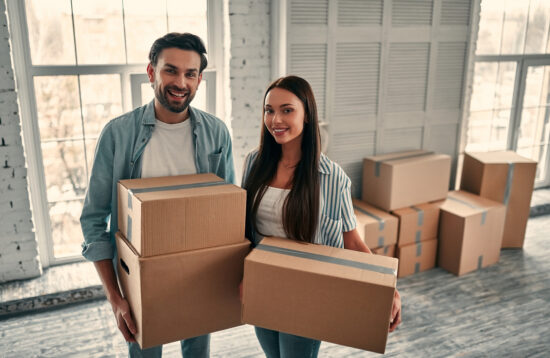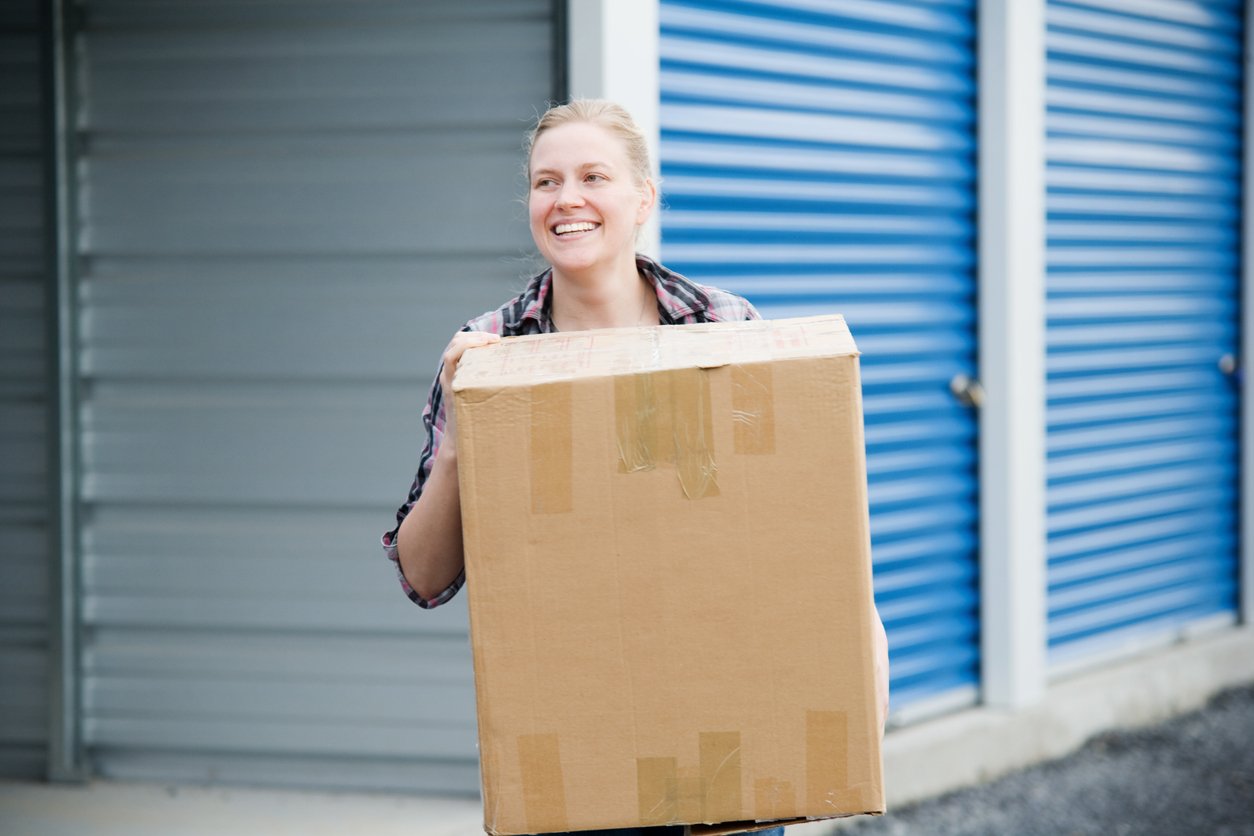Imagine the frustration of digging through disorganized boxes, whether you’re braving the chill of an outdoor unit or navigating the maze of an indoor facility. The challenge of locating a single item in a sea of belongings can be daunting, turning a quick visit to your storage unit into a prolonged and stressful ordeal.
A well-organized storage space can transform this common frustration into a hassle-free experience. Learn how to turn your disorganized storage space into a model of efficiency to ensure quick and easy access to your belongings when you need them most.
How to Organize a Storage Unit: 7 Tips
Organizing a storage unit requires strategic planning and smart packing. The average cost of a storage unit in 2023 is between $75 and $300 a month, meaning you’ll want to maximize every square inch of space you’re paying monthly for.
Additionally, with the right organizational skills, you may be able to fit the same amount of belongings in a 5’x10′ unit that others might store in a 10’x10′ unit, meaning you can rent a smaller, less expensive unit rather than paying more for a larger one.
Here are some essential steps to consider:
Tip #1: Create an Inventory List
When you are planning to place many items in a storage unit, it can be challenging to remember all of them unless you:
- Make a detailed list of all your items.
- Use a spreadsheet to record details about the items, such as their condition, especially if you need to insure them.
- Take photos for a visual inventory.
- Categorize items by type or room for easier reference.
Tip #2: Consider Storing Items in Clear Plastic Bins Rather Than Cardboard Boxes
While traditional cardboard boxes are okay to use in a storage unit, there are better ways to organize your storage unit:
- Use clear bins for easy visibility.
- If using boxes, label them clearly on multiple sides.
- Arrange your belongings by grouping similar items together, such as placing all holiday decorations in one area and keeping all sports equipment in another.
- Consider color-coding plastic containers for different categories.
Tip #3: Disassemble Furniture and Utilize Vertical Storage
Strategically positioning heavy items is crucial for both stability and efficient use of space. For example, when storing a dining room table, it’s not advisable to place it atop a pile of boxes, as this could lead to instability and potential damage.
To prevent toppling and shifting and maximize your available space, you can also:
- Place heavier items, like furniture, on the floor of the unit, ensuring they are evenly distributed.
- Disassemble bulky items like bed frames and tables.
- Store large items, such as sofas, dressers, and bookshelves, vertically and mattresses horizontally.
- Wrap components of disassembled furniture, such as table legs, shelves, or bed frames, as well as delicate items like lampshades or electronics, in protective material to prevent damage.
- Label each part and keep screws and fittings together.
Tip #4: Store Larger, Heavy Items at the Bottom and Towards the Back
Heavy items can cause damage if they’re not stored properly. So, when you’re packing things into the storage unit:
- Position bulky and heavy items towards the back and at the bottom of the unit.
- Consider using sturdy shelving for heavy items to organize and support the weight of these items more effectively.
- Ensure that heavier items are not concentrated in one area. This makes it easier to access items without rearranging large, heavy stacks.
Tip #5: Store Items That You Frequently Need Towards the Front
Chances are that there are items that you plan to use more regularly than others. You’re more likely to retrieve your skiing gear each year than your childhood mementos. To ensure the things you need are accessible:
- Place frequently used items at the front.
- Label these boxes for quick identification.
- Use open-top bins or baskets for easy access.
- Keep a separate, smaller “essentials” box for critical items.
Tip #6: Go Vertical
Many storage units have a lot of wasted vertical space. To make sure you don’t underutilize vertical space:
- Stack boxes high, but ensure the stability of heavy boxes by placing them at the bottom.
- Add shelves for extra storage.
- Keep a stool or ladder for accessing high items.
- Use wall-mounted hooks or pegs for hanging items.
Tip #7: Label Every Box and Bin Inside the Storage Unit
You may think that you’ll recall where you put special items, but it’s tough to remember these things when they’ve been in storage for a long time or are hiding in an opaque container. Avoid losing track of your stored items by completing the following:
- Label each box and bin with contents.
- Position labels to face the unit’s entrance.
- Use waterproof and tear-resistant labels for durability.
- Update labels if contents change over time.
How to Pick the Best Storage Unit Size for Your Needs
When selecting a storage unit, size matters.
- Small Units (5’x5′ to 5’x10′ feet) are ideal for boxes, small furniture, or seasonal items.
- Medium Units (10’x10′ to 10’x15′ feet) are suitable for a one-bedroom apartment’s contents.
- Large Units (10’x20′ feet and up) are great for multi-bedroom homes, large furniture, or vehicles.
The storage unit that best fits your needs will also depend on factors such as:
- Cost
- Intended use.
- Intended length of storage.
- The amount of stuff you want to store.
Here are some key tips and questions to help you choose the best unit.
Step #1: Determine the Primary Function of the Storage Unit
The first step is to think about why you’re storing your belongings. The function of the storage unit will determine the size of the storage unit that best fits your needs.
For example, suppose you are thinking of storing business inventory. Then, it is advisable to rent a larger unit that affords you room for growth. But if you only need to keep items during a temporary move, then picking a unit that’s ideal for your initial belongings is your best move.
When organizing your storage unit, ask yourself the following questions:
- Do I need a temporary or permanent storage unit?
- Will I be rotating items in and out of the storage unit?
- Is it for business, personal items, or a vehicle?
- Do your items need to be kept under specific conditions, like a temperature-controlled environment? (Note that not all storage facilities offer climate-controlled units in every size, so you might be limited to the sizes available with this feature).
- Will you need regular access, like 24-hour access, to rotate items in and out?
Step #2: Develop a Preliminary Inventory
You probably have a general idea of the items you want to keep in a storage unit. However, creating a list can be helpful to capture all the items that need to be stored. When creating an inventory, you’ll need to complete the following to-dos:
- Count the number of boxes you’ll be storing.
- Take rough measurements of larger pieces.
- Record serial numbers of electronics or high-value items in case of theft or loss.
- Mark items that you might need to access frequently so you can store them for easier access.
Step #3: Estimate the Storage Unit Size and Dimensions
You don’t want to pay for more space than you actually need. That’s why it’s important to create some sort of visual reference to get a sense of how much room you’re dealing with and what will fit in it.
- Use masking tape or painter’s tape to mark off a space the size of an average unit in your driveway or any other open space. Then, place some empty moving boxes inside to see how fast the area gets filled.
- Compare the dimensions of the suggested storage unit size to a familiar space in your home, like a garage or a spare bedroom.
- Factor in the need for a walkway, especially if you’ll access the unit frequently.
- Utilize the online size guides or calculators provided by storage facilities
Step #4: Whenever You’re in Doubt, Go One Size Bigger
While it may seem economical to pick the exact storage unit size, it’s a good idea to leave yourself a little leeway.
Moving storage units is challenging, so give yourself some extra space to store spare items in the future. Also, keep in mind that there are instances when a larger-sized storage unit is only a few dollars more per month. Consider the following when choosing a unit:
- A larger unit reduces the risk of stacking boxes too high.
- More space allows for better organization.
- Overcrowding can lead to damaged items.
Step #5: Consider the Types of Items Being Stored
Storing boxes is straightforward as they are easy to stack and measure. However, items like mirrors, couches, wine collections, or fragile sculptures may not be stackable and could require additional space for protective packaging.
- Factor in some extra room when storing fragile items in case they need protective packaging or are not stackable.
- Consider how large items will fit into the unit and whether they can be disassembled to save space.
- If your storage needs vary with the seasons (like holiday decorations or seasonal sports equipment), plan for extra space to accommodate these rotating items.
Step #6: Understand Storage Unit Dimensions
Storage units are sized by length and width, offering an estimate of the available floor space in square feet. To gauge the size you need, consider the square footage required for the contents of each room you’re storing.
- Keep in mind that storage units typically have a ceiling height of 8 feet.
- Tall shelving units or stacking boxes can help maximize space.
- Check the size of the unit’s door. Large items need to fit through this space comfortably without risk of damage.
If you’re storing the contents of a room, a rough guide is that a small bedroom typically fits into a 5’x10’ unit, while a two-bedroom apartment might need a 10’x20’ unit.
Ready to Rent a Storage Unit?
Whether you’re in the midst of moving, downsizing, traveling, or simply decluttering your home, finding the right storage unit is crucial. Neighbor is a peer-to-peer storage marketplace that connects you with storage options that are not only conveniently located but also perfectly sized to fit your unique requirements. Our platform makes it easy to find a storage solution that’s both affordable and close to home.









